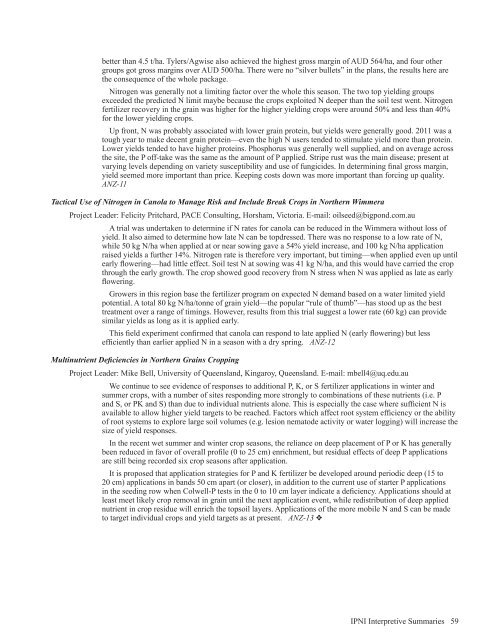Americas and Oceania Group - International Plant Nutrition Institute
Americas and Oceania Group - International Plant Nutrition Institute
Americas and Oceania Group - International Plant Nutrition Institute
Create successful ePaper yourself
Turn your PDF publications into a flip-book with our unique Google optimized e-Paper software.
etter than 4.5 t/ha. Tylers/Agwise also achieved the highest gross margin of AUD 564/ha, <strong>and</strong> four other<br />
groups got gross margins over AUD 500/ha. There were no “silver bullets” in the plans, the results here are<br />
the consequence of the whole package.<br />
Nitrogen was generally not a limiting factor over the whole this season. The two top yielding groups<br />
exceeded the predicted N limit maybe because the crops exploited N deeper than the soil test went. Nitrogen<br />
fertilizer recovery in the grain was higher for the higher yielding crops were around 50% <strong>and</strong> less than 40%<br />
for the lower yielding crops.<br />
Up front, N was probably associated with lower grain protein, but yields were generally good. 2011 was a<br />
tough year to make decent grain protein—even the high N users tended to stimulate yield more than protein.<br />
Lower yields tended to have higher proteins. Phosphorus was generally well supplied, <strong>and</strong> on average across<br />
the site, the P off-take was the same as the amount of P applied. Stripe rust was the main disease; present at<br />
varying levels depending on variety susceptibility <strong>and</strong> use of fungicides. In determining final gross margin,<br />
yield seemed more important than price. Keeping costs down was more important than forcing up quality.<br />
ANZ-11<br />
Tactical Use of Nitrogen in Canola to Manage Risk <strong>and</strong> Include Break Crops in Northern Wimmera<br />
Project Leader: Felicity Pritchard, PACE Consulting, Horsham, Victoria. E-mail: oilseed@bigpond.com.au<br />
A trial was undertaken to determine if N rates for canola can be reduced in the Wimmera without loss of<br />
yield. It also aimed to determine how late N can be topdressed. There was no response to a low rate of N,<br />
while 50 kg N/ha when applied at or near sowing gave a 54% yield increase, <strong>and</strong> 100 kg N/ha application<br />
raised yields a further 14%. Nitrogen rate is therefore very important, but timing—when applied even up until<br />
early flowering—had little effect. Soil test N at sowing was 41 kg N/ha, <strong>and</strong> this would have carried the crop<br />
through the early growth. The crop showed good recovery from N stress when N was applied as late as early<br />
flowering.<br />
Growers in this region base the fertilizer program on expected N dem<strong>and</strong> based on a water limited yield<br />
potential. A total 80 kg N/ha/tonne of grain yield—the popular “rule of thumb”—has stood up as the best<br />
treatment over a range of timings. However, results from this trial suggest a lower rate (60 kg) can provide<br />
similar yields as long as it is applied early.<br />
This field experiment confirmed that canola can respond to late applied N (early flowering) but less<br />
efficiently than earlier applied N in a season with a dry spring. ANZ-12<br />
Multinutrient Deficiencies in Northern Grains Cropping<br />
Project Leader: Mike Bell, University of Queensl<strong>and</strong>, Kingaroy, Queensl<strong>and</strong>. E-mail: mbell4@uq.edu.au<br />
We continue to see evidence of responses to additional P, K, or S fertilizer applications in winter <strong>and</strong><br />
summer crops, with a number of sites responding more strongly to combinations of these nutrients (i.e. P<br />
<strong>and</strong> S, or PK <strong>and</strong> S) than due to individual nutrients alone. This is especially the case where sufficient N is<br />
available to allow higher yield targets to be reached. Factors which affect root system efficiency or the ability<br />
of root systems to explore large soil volumes (e.g. lesion nematode activity or water logging) will increase the<br />
size of yield responses.<br />
In the recent wet summer <strong>and</strong> winter crop seasons, the reliance on deep placement of P or K has generally<br />
been reduced in favor of overall profile (0 to 25 cm) enrichment, but residual effects of deep P applications<br />
are still being recorded six crop seasons after application.<br />
It is proposed that application strategies for P <strong>and</strong> K fertilizer be developed around periodic deep (15 to<br />
20 cm) applications in b<strong>and</strong>s 50 cm apart (or closer), in addition to the current use of starter P applications<br />
in the seeding row when Colwell-P tests in the 0 to 10 cm layer indicate a deficiency. Applications should at<br />
least meet likely crop removal in grain until the next application event, while redistribution of deep applied<br />
nutrient in crop residue will enrich the topsoil layers. Applications of the more mobile N <strong>and</strong> S can be made<br />
to target individual crops <strong>and</strong> yield targets as at present. ANZ-13 v<br />
IPNI Interpretive Summaries 59

















